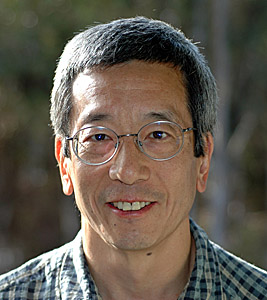UC San Diego’s Tsien Honored with First-Ever “Golden Goose Award”
By:
- Scott LaFee
Published Date
By:
- Scott LaFee
Share This:
Article Content

Roger Tsien, PhD
Roger Tsien, PhD, professor of pharmacology, chemistry and biochemistry at the University of California, San Diego School of Medicine who shared the 2008 Nobel Prize in chemistry for his role in helping develop and expand the use of green fluorescent proteins (GFP) was honored today with one of the first-ever “Golden Goose Awards.”
Eight inaugural Golden Goose recipients were honored today at a Capitol Hill ceremony in Washington, D.C. The award was conceived by U.S. Representative Jim Cooper (D-Tenn) to celebrate scientists “whose research was funded by the federal government and benefited society in some important way, such as a new technology or an advance in health, but which seemed odd or obscure at the time it was conducted, or led to that benefit unexpectedly or serendipitously.” It is supported by several notable scientific and educational organizations, among them the American Association for the Advancement of Science, the Association of American Universities and the Progressive Policy Institute.
Tsien was joined by Martin Chalfie and Osamu Shimomura, who shared the 2008 chemistry Prize; Charles Townes, who received the 1964 Nobel Prize in physics for his research leading to the invention of laser technology; and Eugene White, Rodney White and Della Roy, whose study of tropical coral led to the development of new bone grafting materials.
Tsien, a Howard Hughes Medical Institute investigator, Chalfie, a molecular biologist at Columbia University and Shimomura, a professor emeritus at the Marine Biological Laboratory in Woods Hole, Mass, gained international acclaim in 2008 for their studies explaining and expanding the use of GFPs – glowing proteins that researchers now broadly use to peer inside living cells or whole animals, watch molecules interact in real-time and ask questions once thought impossible.
“Our work is often described as building and training molecular spies,” Tsien explained in 2008. “Molecules enter a cell or organism and report back to us what the conditions are, what’s going on with the biochemistry, while the cell is still alive.”
Tsien continues to develop and deepen the beneficial uses of GFPs. Last year, for example, he and colleague Quyen T. Nguyen, MD, assistant professor of head and neck surgery at the UC San Diego School of Medicine, showed in animal models how injectable fluorescent peptides could be used to highlight hard-to-see peripheral nerves, allowing surgeons to avoid them when removing or repairing other tissues.
About the Golden Goose Award
The purpose of the award is to highlight the human and economic benefits of federally funded but perhaps obscure or seemingly odd research that has resulted in major scientific advances and social benefit. Nominees must have received a federally funded research grant within the past 60 years from agencies such as the National Institutes of Health, the National Science Foundation or the Departments of Defense, Agriculture or Energy. Recipients are chosen by a partnership of the award’s founding universities, think tanks, and businesses. Awards will be announced three to four times a year, with an annual ceremony in Washington, D.C. For more information, see www.goldengooseaward.org
Share This:
Stay in the Know
Keep up with all the latest from UC San Diego. Subscribe to the newsletter today.



